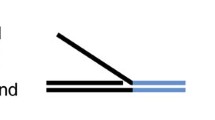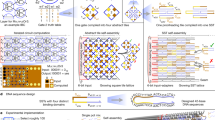Abstract
Mismatched DNA annealing followed by strand replication can cause the programmed evolution of DNA sequences. We have reported that this process is theoretically equivalent in computational power to a desktop computer by demonstrating a constructive way to encode arbitrary computations as DNA molecules within the framework of programmed mutagenesis, a system that consists solely of cycles of DNA annealing, polymerization, and ligation.1,2) Thus, programmed mutagenesis is theoretically universal and we report here the experimental efficiency of its primitive operations. The measured efficiency of an in vitro programmed mutagenesis system suggests that segregating the products of DNA replication into separate compartments would be an efficient way to implement molecular computation. For computer science, using single DNA molecules to represent the state of a computation holds the promise of a new paradigm of composable molecular computing. For biology, the demonstration that DNA sequences could guide their own evolution under computational rules may have implications as we begin to unravel the mysteries of genome encoding and natural evolution.
Similar content being viewed by others
References
Khodor, J. and Gifford, D. K., “Programmed Mutagenesis is a Universal Model of Computation,” to appear in a special issue ofLecture Notes in Computer Science, Springer-Verlag, 2002.
Khodor, J. and Gifford, D. K., “Programmed Mutagenesis is Universal,” to appear in a special issue ofTheory of Computing Systems, Springer-Verlag, 2002.
Adleman, L., “Molecular Computation of Solutions to Combinatorial Problems,”Science, 266, 5187, pp. 1021–1024, 1994.
Lipton, R. J., “DNA Solution to Computational Problems,”Science, 268, 5210, pp. 542–545, 1995.
Boneh, D., Dunworth, C., Lipton, R. J., and Sgall, S., “On the Computational Power of DNA,”Discrete Applied Mathematics, 71, 1–3, pp. 79–94, 1996.
Komiya, K., Sakamoto, K., Gouzu, H., Yokoyama, S., Arita, M., Nishilkawa, A., and Hagiya, M., “Successive State Transitions with I/O Interface by Molecules,”in Proc. of Sixth International Meeting on DNA Based Computers, Preliminary, pp. 21–30, 2000.
Sakamoto, K. Gouzu, H., Komiya, K., Kiga, D., Yokoyama, S., Yokomori, T., and Hagiya, M., “Molecular Computation by DNA Hairpin Formation,”Science, 288, 5469, pp. 1223–1226, 2000.
Kari, L. and Thierrin, G., “Contextual Insertions/Deletions and Computability,”Information and Computation, 131, pp. 47–61, 1996.
Landwebber, L. F. and Kari, L., “The Evolution of Cellular Computing: Nature's Solution to a Computational Problem,”Biosystems, 52, pp. 3–13, 1999.
Beaver, D., “Molecular Computing,”1st DIMACS Workshop on DNA-based computers, Princeton, DIMACS Series, 27, pp. 29–36, 1996.
Head, T., “Formal Language Theory and DNA: an Analysis of the Generative Capacity of Specific Recombinant Behaviors,”Bulletin of Mathematical Biology, 49, pp. 737–759, 1987.
Paun, G., “Computing with Membranes,”J Comput Syst Sci, 61, pp. 108–143, 2000.
Winfree, E., “On the Computational Power of DNA Annealing and Ligation,”DNA Based Computers II: DIMACS Workshop, June 10–12, 1996, American Mathematical Society, pp. 191–213, 1998.
Mao, C., LaBean, T. H., Reif, J. H. and Seeman, N. C., “Logical Computation Using Algorithmic Self-assembly of DNA Triple-crossover Molecules,”Nature, 407, pp. 493–496, 2000.
Hartemink, A. J., Gifford, D. K. and Khodor, J., “Automated Constraint-Governed Nucleotide Sequence Selection for DNA Computation,”Biosystems, 52, pp. 93–97, 1999.
Khodor, J. and Gifford, D.K., “Design and Implementation of Computational Systems Based on Programmed Mutagenesis,”Biosystems, 52, pp. 227–235, 1999.
Current Protocols in Molecular Biology (Ausubel, I. and Frederick, M., eds), 8.5, John Wiley & Sons, Inc, 1997.
Author information
Authors and Affiliations
Corresponding author
Additional information
Julia Khodor, Ph.D.: She has just received her Ph.D. in Electrical Engineering and Computer Science from MIT and is now enjoying her time off with her new daughter. She received her B.S. in Mathematics with Computer Science and B.S. in Biology in 1996 and her M.S. in Computer Science in 1998, all from MIT. Her graduate research was in the area of biological computing, primarily focusing on programmed mutagenesis. She is looking forward to the joys and challenges of an academic career.
David K. Gifford, Ph.D.: He is a professor of computer science and electrical engineering at MIT, where he leads a research group investigating issues in computational functional genomics. His research interests include understanding data from high-throughput experimental systems using probabilistic modeling techniques. He received a Ph.D. in computer science from Stanford University.
About this article
Cite this article
Khodor, J., Gifford, D.K. Experimental efficiency of programmed mutagenesis. New Gener Comput 20, 307–315 (2002). https://doi.org/10.1007/BF03037363
Received:
Revised:
Published:
Issue Date:
DOI: https://doi.org/10.1007/BF03037363




